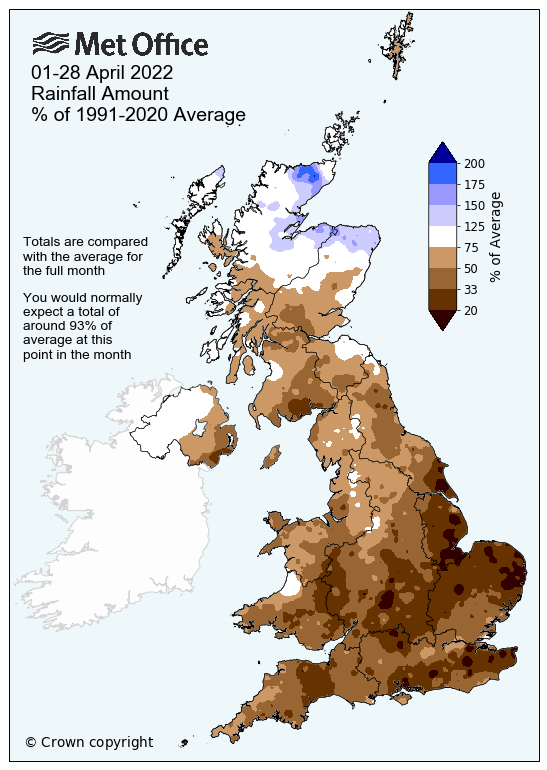
As April draws to a close, another completely dry week for many across Britain, April rainfall looks likely to be less than half of normal for England and Wales as we finish the month.
England has so far seen 41% of its average (23.2mm), Wales 46% (40.7mm), Scotland 82% (76.4mm) and Northern Ireland 78% (57.9mm). The only areas that have been wetter than average are to be found in the north of Scotland, although the west of Northern Ireland has also had near-average rainfall.
Source: Met office Blog: Why has April been so dry?

Source: Met Office - April’s rainfall between 1 April and 28 April, compared to the meteorological average for the month.
The dry April conditions is certainly impacting on river flow across England, many flowing below or well below usual for the time of year:
However, such dry Aprils aren’t actually that unusual and there has been drier Aprils in the recent past, with this April not a record-breaker by any means, not even on a local level. But it certainly seems to be a trend in the last 10-20 years for Aprils becoming drier.
Despite its reputation of being showery, April is often a dry month and is one of the drier months of the year across the UK, some parts the driest month of the year. Some Aprils have been completely rainless across large parts of the UK. April 2007 was a very dry month, England and Wales seeing just 18% of the average, many stations in SE England and East Anglia recorded just 3mm of rain. In 1984, April saw no measurable rain across large parts of southern England.
More recently, 7 out of the last 10 Aprils have been drier than average. Last year April was mostly anticyclonic and was the fourth driest since records began in 1862. April 2020 was also mostly anticyclonic and very dry, with the UK as a whole receiving just 40% of average rainfall. 2019 was also dry overall, with 71% of the average rainfall. April 2017 was well below average, just 48% of the UK average. 2015 was also dry, overall UK total was 63% of the average, England and Wales seeing only 29% of the average. 2013 was dry too, England and Wales saw 57% the average rainfall, the UK as a whole saw 87% of the average.
High pressure blocking over or near the UK has usually been present in some of our driest Aprils, with the Atlantic low pressure track diverted way to the north or to the south of the UK over southern Europe. This month has seen persistent blocking close to the north or northwest of the UK since Easter, keeping rain-bearing Atlantic systems away from the UK. Blocking, like this April, can be partly driven by Sudden Stratospheric Warmings which lead to high latitude blocking, as occurred in late March this year. But also La Nina driven weather patterns around the northern hemisphere could also be behind the long periods of blocking we’ve seen over recent months, not just this month, but also through much of January. Some of the driest Aprils have been during La Nina events.
The models have been pointing towards more unsettled conditions off the Atlantic to start May, though over recent runs have trended drier. Weak low pressure looks like being present through next week – which will likely trigger showers with any warmth from sunny spells. But the showers look to be well-scattered, so they will be hit and miss, with not everywhere catching one each day, some useful rain from the heavier ones, but not really having much impact in moistening the already dry and hard ground for farmers and gardeners alike. It’s been so dry that wildfires are increasingly an issue over moorland and heathland – where there’s a ready supply of dry vegetation coupled with low humidity.
Loading recent activity...